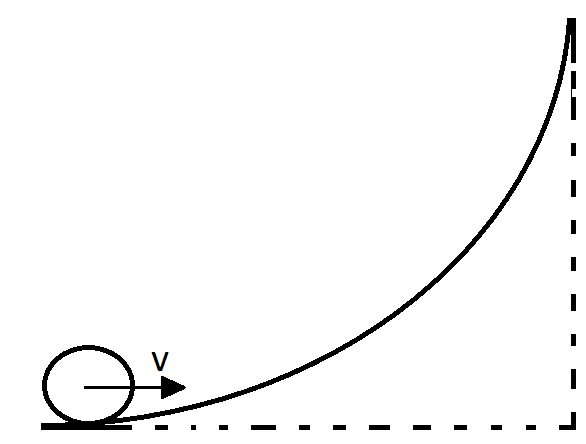
A small object of uniform density rolls up a curved surface with an initial velocity v′. It reaches up to a maximum height \[\dfrac{{3{v^2}}}{{4g}}\] with respect to the initial position. The object is:

A) Ring
B) Solid sphere
C) Hollow sphere
D) Disc
Answer
216k+ views
Hint: The law of conservation of energy states that energy can neither be created nor be destroyed. Although, it may be transformed from one form to another. If you take all forms of energy into account, the total energy of an isolated system always remains constant. All the forms of energy follow the law of conservation of energy.
Here the object is in general motion as we can see that it is going up the curved surface by rolling.
Here object possess three forms of energy
1) Kinetic energy due to rotational motion
2) Kinetic energy due to traversing on the curved path
3) Potential energy due to height it attains on the curved path
As the object rolls up the curved path the sum of its kinetic energies will gradually be converting into potential energy. And at the top point, all the kinetic energy will be transformed into potential energy.
By applying the law of conservation of energy here we can say that
Kinetic Energy due to rotational $ + $Kinetic energy due to transverse motion$ = $potential energy
We know that,
$
{\left( {K.E} \right)_{transverse}} = \dfrac{1}{2}m{v^2} \\
{\left( {K.E} \right)_{rotation}} = \dfrac{1}{2}I{\omega ^2} \\
\left( {P.E} \right) = m \times g \times h \\
$
So the equation becomes
$\dfrac{1}{2}m{v^2} + \dfrac{1}{2}I{\omega ^2} = mgh$_____________________$\left( 1 \right)$
Here,
$m$: mass of the object
$v$: linear velocity of the object
$\omega $: angular velocity of the object
$h$: height attained by the object
$I$: Moment of inertia
$g$: acceleration due to gravity
Complete step by step solution:
We are given that,
The maximum height up to which the object goes is
$h = \dfrac{{3{v^2}}}{{4g}}$
Initial velocity $v = v`$
We know that angular velocity is given by
$
v = r\omega \\
\therefore \omega = \dfrac{v}{r} \\
$
Substituting all the above value in the equation $\left( 1 \right)$
$
\dfrac{1}{2}mv{`^2} + \dfrac{1}{2}I{\dfrac{{v`}}{{{r^2}}}^2} = mg \times \dfrac{{3v{`^2}}}{{4g}} \\
\Rightarrow I = \dfrac{1}{2}m{r^2} \\
$
Here from the above step we got
$I = \dfrac{1}{2}m{r^2}$
We know that this is the equation for the moment of inertia of a disc.
The correct option is (D), the object is a disk.
Note: Whenever there is a conversion of energy from one form to another law of conservation of energy is always satisfied.
In a general motion, there are two motion transverse and rotational
In general motion, there is only one point of contact
Here the object is in general motion as we can see that it is going up the curved surface by rolling.
Here object possess three forms of energy
1) Kinetic energy due to rotational motion
2) Kinetic energy due to traversing on the curved path
3) Potential energy due to height it attains on the curved path
As the object rolls up the curved path the sum of its kinetic energies will gradually be converting into potential energy. And at the top point, all the kinetic energy will be transformed into potential energy.
By applying the law of conservation of energy here we can say that
Kinetic Energy due to rotational $ + $Kinetic energy due to transverse motion$ = $potential energy
We know that,
$
{\left( {K.E} \right)_{transverse}} = \dfrac{1}{2}m{v^2} \\
{\left( {K.E} \right)_{rotation}} = \dfrac{1}{2}I{\omega ^2} \\
\left( {P.E} \right) = m \times g \times h \\
$
So the equation becomes
$\dfrac{1}{2}m{v^2} + \dfrac{1}{2}I{\omega ^2} = mgh$_____________________$\left( 1 \right)$
Here,
$m$: mass of the object
$v$: linear velocity of the object
$\omega $: angular velocity of the object
$h$: height attained by the object
$I$: Moment of inertia
$g$: acceleration due to gravity
Complete step by step solution:
We are given that,
The maximum height up to which the object goes is
$h = \dfrac{{3{v^2}}}{{4g}}$
Initial velocity $v = v`$
We know that angular velocity is given by
$
v = r\omega \\
\therefore \omega = \dfrac{v}{r} \\
$
Substituting all the above value in the equation $\left( 1 \right)$
$
\dfrac{1}{2}mv{`^2} + \dfrac{1}{2}I{\dfrac{{v`}}{{{r^2}}}^2} = mg \times \dfrac{{3v{`^2}}}{{4g}} \\
\Rightarrow I = \dfrac{1}{2}m{r^2} \\
$
Here from the above step we got
$I = \dfrac{1}{2}m{r^2}$
We know that this is the equation for the moment of inertia of a disc.
The correct option is (D), the object is a disk.
Note: Whenever there is a conversion of energy from one form to another law of conservation of energy is always satisfied.
In a general motion, there are two motion transverse and rotational
In general motion, there is only one point of contact
Recently Updated Pages
Alpha, Beta, and Gamma Decay Explained

Alpha Particle Scattering and Rutherford Model Explained

Angular Momentum of a Rotating Body: Definition & Formula

Apparent Frequency Explained: Formula, Uses & Examples

Applications of Echo in Daily Life and Science

Atomic Structure Explained: Key Concepts for Students

Trending doubts
JEE Main 2026: Application Form Open, Exam Dates, Syllabus, Eligibility & Question Papers

JEE Main Correction Window 2026 Session 1 Dates Announced - Edit Form Details, Dates and Link

Derivation of Equation of Trajectory Explained for Students

Hybridisation in Chemistry – Concept, Types & Applications

Understanding the Angle of Deviation in a Prism

Understanding Collisions: Types and Examples for Students

Other Pages
JEE Advanced Marks vs Ranks 2025: Understanding Category-wise Qualifying Marks and Previous Year Cut-offs

Units And Measurements Class 11 Physics Chapter 1 CBSE Notes - 2025-26

NCERT Solutions For Class 11 Physics Chapter 8 Mechanical Properties Of Solids

Motion in a Straight Line Class 11 Physics Chapter 2 CBSE Notes - 2025-26

NCERT Solutions for Class 11 Physics Chapter 7 Gravitation 2025-26

How to Convert a Galvanometer into an Ammeter or Voltmeter




